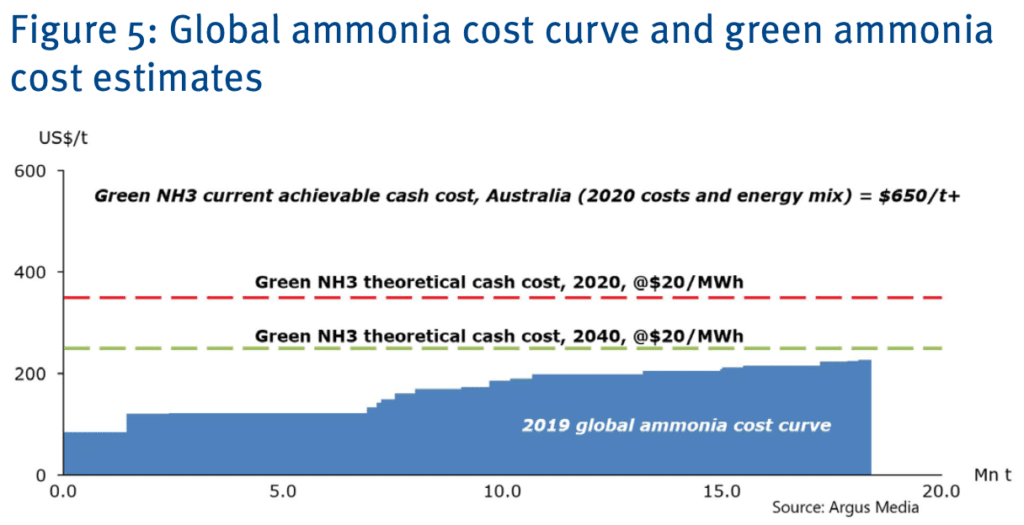Ammonia: Fuel of the Future?
Bolbik / Shutterstock.com
23 February 2023 – by Eric Koons Comments (0)
Why Ammonia As A Fuel is Gaining Popularity?
Ammonia is a colourless gas that is an important raw material for many industries and is gaining popularity as a potential fuel for energy generation. The increasing interest in ammonia’s use for energy mainly comes from the properties that make it easy to store and transport. Also, it’s more energy dense than hydrogen – its main competitor.
Ammonia Production, Use and Fossil Fuels
Currently, the vast majority of ammonia fuel produced is used for fertiliser production. However, the ammonia production process is energy intensive and relies on fossil fuels for energy and raw materials. Global ammonia production consumes 1.8% of the world’s energy and accounts for 1.8% of global carbon dioxide emissions. This is more than the output of South Africa from all fossil fuel use, and South Africa gets 92% of its energy from fossil fuels.

However, in a similar way that hydrogen production can be either carbon-intensive or carbon-neutral, ammonia production is the same. The carbon emissions from ammonia production almost entirely depend on the energy input. If renewable energy is the input, there are minimal emissions.
As a result, both hydrogen and ammonia are potential renewable fuel sources. Renewable fuels will play an important role as the world decarbonises, particularly for hard-to-decarbonise industries – like fertiliser production.
Making Ammonia Fuel
Ammonia fuel is made by combining nitrogen and hydrogen through a process known as Haber-Bosch. The Haber-Bosch process utilises a reactor with high pressure (200 atmospheres) and temperatures (500 degrees Celsius) to force hydrogen and nitrogen to bond, forming ammonia – NH3. Ammonia forms as a gas and is then cooled into a liquid at -33 degrees Celsius for storage.
The reaction’s high pressure and temperature requirements make the process energy intensive. Additionally, the most common source of hydrogen used in ammonia production comes from natural gas – a fossil fuel. Both of these facts make current ammonia production extremely reliant on fossil fuels and a significant emitter of CO2.

Green Ammonia Fuel: The Low-carbon Alternative
Alternatively, producing low-carbon, sustainable green ammonia fuel is possible, limiting its reliance on fossil fuels. Harnessing renewables for the energy input and using hydrogen from water instead of natural gas are green alternatives.
Unfortunately, water electrolysis, the process used to generate hydrogen from water, is still expensive and not at a scale to replace natural gas hydrogen production. As technology improves and costs fall, this may become a viable alternative.
Ammonia Fuel Cell vs Hydrogen: Is Ammonia Better Than Hydrogen?
Ammonia is better than hydrogen fuel. People often see ammonia and hydrogen as similar energy sources, as both act as energy carriers for the energy initially used in their production. Additionally, hydrogen is an input for ammonia production, so hydrogen’s production method heavily impacts the total emission of ammonia.
However, ammonia has many beneficial properties that make it a better end-fuel source than hydrogen, even though it takes additional energy to convert hydrogen into ammonia.

1. Ammonia Fuel is Easy to Transport and Store
Ammonia does not require as extreme conditions as hydrogen during transportation and storage. Hydrogen gas must be stored in high-pressure tanks at 340 atmospheres or as a liquid in cryogenic conditions of -252 degrees Celsius. Comparatively, liquid ammonia only requires –33 degrees Celsius for storage. Not only do these easier storage conditions mean it is safer and cheaper to store ammonia, but it is also less energy intensive.
2. Ammonia Can Produce More Energy than Hydrogen
Ammonia is more energy dense than hydrogen. Liquid ammonia has an energy density of 15.6 MJ/L compared to liquid hydrogen at 9.1 MJ/L and gaseous, compressed hydrogen at 5.6 MJ/L. Higher energy density means less ammonia to produce the same amount of energy. Ultimately, this translates to a more versatile fuel.
3. Infrastructure for Ammonia Is Already Established
The ammonia industry is already well-established for industrial use. The trading, transport and storage infrastructure is in place at around 200 ports globally. The energy industry can expand this infrastructure to meet further capacity needs. On the other hand, the lack of hydrogen infrastructure is one of the biggest concerns for the hydrogen industry.
Can Ammonia Fuel Be a Renewable Energy Source for the Future?
Ammonia fuel can be a viable, low-carbon energy source for the future. It has properties that make it an excellent option for several use cases. However, the vast majority of ammonia comes from fossil fuels, and green ammonia is still a nascent industry.

Before renewable ammonia is viable, green hydrogen prices must fall significantly. Currently, the International Renewable Energy Agency (IRENA) estimates that producing one tonne of ammonia from green hydrogen costs up to USD 1,400, whereas using natural gas costs up to USD 340. This price gap makes it challenging to incentivise the industry to switch to renewable, green hydrogen production.
Solving the price concerns largely falls on improving hydrogen water electrolysis, which is one of the main barriers to green hydrogen production. Government investments in R&D, incentives for industry and subsidies all have an essential role in reducing this price gap.
Regardless, the future of renewable energy is exciting and necessary. With continued advancements in technology, ammonia fuel has the potential to play a significant role in the transition towards a more sustainable future.
by Eric Koons
Eric is a passionate environmental advocate that believes renewable energy is a key piece in meeting the world’s growing energy demands. He received an environmental science degree from the University of California and has worked to promote environmentally and socially sustainable practices since. Eric’s expertise extends across the environmental field, yet he maintains a strong focus on renewable energy. His work has been featured by leading environmental organizations, such as World Resources Institute and Hitachi ABB Power Grids.
Read more

